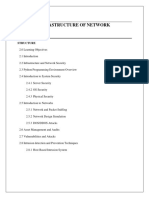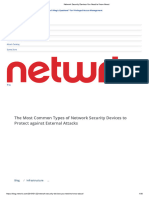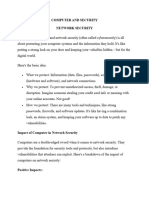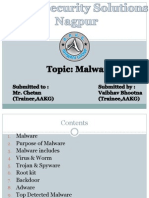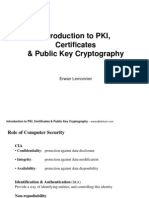Network Security - A Layered Approach: H. I. M. T. Greater Noida, D. N. College, Hisar, G. P. Hisar
Network Security - A Layered Approach: H. I. M. T. Greater Noida, D. N. College, Hisar, G. P. Hisar
Uploaded by
srs0507Copyright:
Available Formats
Network Security - A Layered Approach: H. I. M. T. Greater Noida, D. N. College, Hisar, G. P. Hisar
Network Security - A Layered Approach: H. I. M. T. Greater Noida, D. N. College, Hisar, G. P. Hisar
Uploaded by
srs0507Original Title
Copyright
Available Formats
Share this document
Did you find this document useful?
Is this content inappropriate?
Copyright:
Available Formats
Network Security - A Layered Approach: H. I. M. T. Greater Noida, D. N. College, Hisar, G. P. Hisar
Network Security - A Layered Approach: H. I. M. T. Greater Noida, D. N. College, Hisar, G. P. Hisar
Uploaded by
srs0507Copyright:
Available Formats
Network Security A Layered Approach
Kanchan Bala1, Barjeena Lucky2, Surinder Pal Garg3 H. I. M. T. Greater Noida, 2D. N. College, Hisar, 3G. P. Hisar.
Abstract
Security issues are critical for the success of pervasive computing. Because pervasive computing and ebusiness may provide millions of people with the power to move trillions of dollars in goods or money by a few mouse clicks, the security of e-business transaction is a top priority. With the number of security threats on the rise, network security has become an essential part of maintaining the privacy and integrity of an enterprise. Network security provider has the technology to help you define your network against attacks by implementing preventative security solutions. Cryptography is a minor tool to obtain Network Security. Our layered approach to network security was designed with the knowledge that no single tool can protect every segment of network from harming. In reality, the surge of blended threats has resulted in the need for integration between individual security products in order to reduce possible gaps in protection.
methodical approach to network security. In many industries enhanced security is not an option-its mandatory federal regulation such as sarbnessoxelyGLBA and other require organizations such as financial institutions, health care providers and federal agencies to implement stringent security programs to protect digital assets. Now we are introducing you to a layered approach for securing your network. This layered approach is both a technical strategy, espousing adequate measures be put in place at different levels within your network infrastructures. The layered approach centers on maintaining appropriate security measures and procedures at five different levels within IT department. 1. Perimeter 2. Network 3. Host 4. Application 5. Data
1. Introduction
Network layer security is a key aspect of the internet based security mechanism. Originally; people were concentrating only on application level security. However, new security requirements demand that even the lower level data units should be protected. With the view in mind, network security mechanism has emerged and is being used extensively in real life.
Figure 2. The security level in the layered approach and the technologies that function on each.
Figure 1. Network security A Layered Approach Network security is a mission-critical concern for enterprises, government agencies, and organizations of all sizes. Todays advanced threats demand a
2. Perimeter Security (Level 1)
The perimeter is the first line of defense from outside, un-trusted networks. The perimeter acts as the first and last point of contact for security defenses protecting the network. It is the area where your network ends and the Internet begins. The perimeter consists of one or more firewalls and a set of strictly controlled servers located in a portion of the perimeter referred to as the DMZ (demilitarized zone). A DMZ typically contains the Web Servers, email gateway, network antivirus and DNS servers that must be exposed to the internet. A compromised network perimeter can cripple your ability to conduct business. For Example, if your organization relies on your Web servers for revenue generation, and those servers have been hacked and are off-line, you lose money for every minute they are down. The following technologies provide security at the network perimeter.
2.2 Network Based Anti - Virus
Installed in the DMZ, network based anti -virus software compares incoming and outgoing email message content to a database known virus profiles. Network based anti-virus products block infected email traffic by quarantining suspicious and infected e-mail messages and then notifying recipients and administrators. This prevents email infected with a virus from entering and spreading across your network, and it prevents your network from spreading virus infected email. To work effectively, the database of known viruses must be kept up to date.
2.3 VPN
A VPN is a mechanism of employing encryption, authentication and integrity protection so that we can use a public network (Such as the Internet) as if it is a private network. A VPN is a mechanism to simulate a private network over a public network. It essentially creates an encrypted tunnel across the Internet, approximating the security and confidentiality of a private network. A VPN tunnel can terminate on a VPN- enabled router, firewall or server within the DMZ. Enforcing VPN connections for all remote and wireless network segments is an important bestpractice that is relatively easy and inexpensive to implement.
2.1 Firewall
A firewall is typically installed on a server connected to the inside and the outside of the network perimeter. A firewall performs three general functions: 1. Traffic Control 2. Address Translations 3. VPN terminations A firewall acts like a sentry. If implemented, it guards a corporate network by standing between the network and the outside world. All the traffic between the network and the internet in either direction must pass through the firewall. The firewall decides if the traffic can be allowed to flow or whether it must be stopped from proceeding further. It ensures that only permissible requests are allowed through. Additionally, firewalls help secure the network by translating internal IP addresses to IP addresses that are visible to the internet. This prevents the disclosure of critical information about the structure of the network inside the firewall. A firewall can also terminate VPN tunnels.
3. Network Security (Level 2)
The network level of the layered security model refers to your internal LAN and WAN. The following technologies provide security at network level:
3.1 Intrusion Detection System (IDS) and Intrusion Prevention System (IPS)
IDS and IPS technologies analyze traffic moving across your network in much greater detail than your firewall. Similar to antivirus systems, IPS and IDS devices analyze traffic and compare each packet to a database of known attack profiles. The difference is that anti- virus inspects files on the system, whereas IDS and IPS inspects packets within network traffic. When attacks are detected, IDS/IPS technologies take action. IDS alert and IPS block the harmful traffic. In fact, most IPSs have an IDS at their core. The key difference between the technologies is implied by their names. IDS products only detect malicious traffic, while IPS products prevent such traffic from entering your network.
Figure 3. Firewall Installation
3.2 Vulnerability Management
Vulnerability management system performs two related function. They scan the network for source addresses, TCP state verification, and rouge services running on the network. They manage the process of
3.3 Network access control
Network access control solutions protect the network by ensuring that endpoints meet defined security standard before they are allowed to access the network. Endpoints security solutions allow or deny access based on tests run against a device when it attempts to connect. They typically test for (1) required software, such as service packs, up to date antivirus definitions, etc. and (2) prohibited applications, such as file sharing and spyware.
3.4 Access Control and User Authentication
Access control entails authenticating users who access your network. Authentication is typically performed against the user information in a RADIUS, LDAP or Window ACTIVE directory.
Figure 4. Intrusion Detection System
4. Host Security (Level 3)
In the layered security model, the host level pertains to the individual devices, Such as servers, switches, routers etc on the network. Each device has a number of configurable parameters that, when set inappropriately, can creater exploitable security holes. These parameters include registry settings, services operating on the device, or patches to the operating system or important applications. The following technologies provide security at host level.
Figure 5. Intrusion prevention system (out-of-band configuration)
4.1 Host based Intrusion Detection System
Host based IDs perform similarly to network IDsthe key difference being that they monitor traffic on a single network device. Host based IDs are fine tuned to the specific operational characteristics of the host device and therefore provide a high degree of protection when properly administered.
4.2 Host Based Vulnerability Assessment
Figure 6. Intrusion prevention system (In-Line Configuration) repairing the vulnerabilities found. Vulnerability managers scan devices on a network for flaws and vulnerabilities that could be exploited by hackers or harmful traffic. They typically maintain a database of rules that identify known vulnerabilities for a range of network devices and applications. Host base VA tool scan a single network device for security vulnerabilities. Host based VA tools are fine tuned to the device they are monitor. They are extremely accurate and make minimal demands on the hosts resources. Because they are configured specifically for the host device, they provide an excellent level of coverage when properly administered.
4.3 Network Access Control
Network access control solutions do double duty, protecting both the network and individual hosts. These solutions continually check the host for harmful applications and infection and also verify that required security measures, such as anti-virus and personal firewalls are installed and up to date.
6.1 Encryption
Data encryption schemes are commonly implemented at the data, the application, and the operating systems levels. Common encryption strategies include PKI, PGP and RSA.
6.2 Access Control / User Authentication
Like network, and host and application level authentication, only authorized users are given to access data.
4.4 Anti Virus
Device-specific anti-virus applications provide an additional layer of protection when used in conjunction with network based anti-virus tools.
7. Conclusion
Hackers and cyber terrorist are launching network attack combines with increasing frequency and sophistication. The traditional approach to securitynamely a firewall combined with an anti-virus in incapable of protecting. However, erect a formidable defense by implementing network security using a layered approach.
5. Application Security (Level 4)
Application level security is currently receiving a great deal of attention. Poorly protected applications can provide easy access to confidential data and records. The hard truth is that most programmers dont code with security in mind. Applications are being placed on the web for access by customers, partners or even remote employees with increasing frequency. The following technologies provide security at the application level:
8. References
[1] R.T. Morris, 1985, A Weakness in the 4.2BSD Unix TCP/IP Software, Computing Science Technical Report No. 117, AT&T Bell Laboratories, Murray Hill, New Jersey. [2] S.M. Bellovin, Security Problems in the TCP/IP Protocol Suite, Computer Communication Review, Vol. 19, No. 2, pp. 32-48, April 1989. [3] Y. Rekhter, R. Moskowitz, D. Karrenberg, G. de Groot, E. Lear, ``Address Allocation for Private Internets.'' RFC 1918. [4] J.P. Holbrook, J.K. Reynolds. ``Site Security Handbook.'' RFC 1244. [5] M. Curtin, ``Snake Oil Warning Signs: Encryption Software to Avoid.'' USENET <sci.crypt> Frequently Asked Questions File.
5.1 Application Shield
An application shield is frequently referred to as an application-level firewall. In ensures that incoming and outgoing requests are permissible for the given application. Commonly installed on web servers, email servers, database servers and similar machines, an application shield is transparent to the user but highly integrated with the device on the backend.
6. Data Security (Level 5)
Data level security entails a blend of policy and encryption. Encryption data where it resides and as it travels across your network is a recommended best practice because, if all other security measures fail, a strong encryption scheme protects your proprietary data. Data security is highly dependent on organization wide policies that govern who have access to data, what authorized users can do with it, and who has ultimately responsibility for its integrity and safe keeping. The following technologies provide security at data level:
You might also like
- CEH: Certified Ethical Hacker v11 : Exam Cram Notes - First Edition - 2021From EverandCEH: Certified Ethical Hacker v11 : Exam Cram Notes - First Edition - 2021No ratings yet
- Literature Review On Cyber CrimeDocument4 pagesLiterature Review On Cyber CrimePaul Isaiah57% (7)
- AZURE AZ 500 STUDY GUIDE-1: Microsoft Certified Associate Azure Security Engineer: Exam-AZ 500From EverandAZURE AZ 500 STUDY GUIDE-1: Microsoft Certified Associate Azure Security Engineer: Exam-AZ 500No ratings yet
- CybersecurityDocument77 pagesCybersecurityshopnopoka95% (19)
- Ethical Hacking HartleyDocument22 pagesEthical Hacking HartleyApte SatishNo ratings yet
- Ethics in Information Technology, Second Edition: Computer and Internet CrimeDocument49 pagesEthics in Information Technology, Second Edition: Computer and Internet Crimecarl_abanganNo ratings yet
- Topic 2. Network SecurityDocument5 pagesTopic 2. Network SecurityRosetephanie ZalunNo ratings yet
- Ijaerv14n15spl 13Document4 pagesIjaerv14n15spl 13Rana ShubhamNo ratings yet
- Briefly Describe Network SecurityDocument4 pagesBriefly Describe Network SecurityAlem GirmaNo ratings yet
- Module 3 Computer Network SecurityDocument5 pagesModule 3 Computer Network SecurityMac John Teves PobleteNo ratings yet
- NetworkSecurityFinalDocument7 pagesNetworkSecurityFinalMd. Ziaul Haque ShiponNo ratings yet
- Network Security DesignDocument5 pagesNetwork Security DesignMahbubur RahmanNo ratings yet
- Wireless Network Security Vulnerabilities Threats and CountermeasuresDocument6 pagesWireless Network Security Vulnerabilities Threats and CountermeasuresMaria BatoolNo ratings yet
- FirewallDocument8 pagesFirewallUday RoyNo ratings yet
- Grade 10-12 - Week 5Document4 pagesGrade 10-12 - Week 5Oliver C Silvano100% (1)
- Need For Network SecurityDocument8 pagesNeed For Network SecurityRyan CooperNo ratings yet
- Network Security-Research PaperDocument5 pagesNetwork Security-Research PaperAbhi ChauhanNo ratings yet
- Unit - 2: Infrastructure of Network Security: StructureDocument44 pagesUnit - 2: Infrastructure of Network Security: StructureSreeprada VNo ratings yet
- JizupiwalaDocument4 pagesJizupiwalaSilki ChakrabortyNo ratings yet
- Valnurabiloity AssessmentDocument5 pagesValnurabiloity AssessmentBlessing ShenjeNo ratings yet
- Presetation Report ON Network Security: Submitted To:-Submitted By: - Ms. Amba Ramneek Kaur Faculty, MRIU FET/CS(s) /2092Document19 pagesPresetation Report ON Network Security: Submitted To:-Submitted By: - Ms. Amba Ramneek Kaur Faculty, MRIU FET/CS(s) /2092Tushar ChandhokNo ratings yet
- Dimaano, Zareena A. (IT 112 REPORT NOTES)Document7 pagesDimaano, Zareena A. (IT 112 REPORT NOTES)Zareena AgapanNo ratings yet
- Lesson 1 Network SecurityDocument3 pagesLesson 1 Network SecurityBelle SebullenNo ratings yet
- Firewall: What Is A Firewall?Document4 pagesFirewall: What Is A Firewall?Naveen AdaikkalamNo ratings yet
- Firewalls For Network SecDocument48 pagesFirewalls For Network Sectarnedo1No ratings yet
- Network Security Devices You Need To Know AboutDocument30 pagesNetwork Security Devices You Need To Know Aboutramya.gNo ratings yet
- A Literature Survey On Network Attacks and Prevention: AbstractDocument7 pagesA Literature Survey On Network Attacks and Prevention: Abstractmani DILLSNo ratings yet
- Basic Concepts of Network SecurityDocument16 pagesBasic Concepts of Network SecurityRajkumar DharmarajNo ratings yet
- DCC Micro-4Document22 pagesDCC Micro-4rcq5f8bgpkNo ratings yet
- System For IntrusionDocument8 pagesSystem For IntrusionVictoria OdemakinNo ratings yet
- Network SecurityDocument13 pagesNetwork SecurityGra VaqueroNo ratings yet
- Design and Implementation of A Network Security Model For Cooperative NetworkDocument11 pagesDesign and Implementation of A Network Security Model For Cooperative NetworkJitendra Yadav100% (1)
- Network SecurityDocument24 pagesNetwork SecurityTee ZeeNo ratings yet
- Research ProjectDocument8 pagesResearch ProjectAlvin ChiengNo ratings yet
- Welcome To International Journal of Engineering Research and Development (IJERD)Document7 pagesWelcome To International Journal of Engineering Research and Development (IJERD)IJERDNo ratings yet
- Assignment 3 Network SecurityDocument7 pagesAssignment 3 Network Securitykainat KhalidNo ratings yet
- Ola Moor SeminarDocument8 pagesOla Moor Seminarelfaruk37No ratings yet
- Security PostureDocument4 pagesSecurity Posturerampagesins23No ratings yet
- Cybersecurity Interview QuestionsDocument8 pagesCybersecurity Interview QuestionsMAJID ABDULLAHNo ratings yet
- Internet Firewalls: BY T. Naveen KumarDocument11 pagesInternet Firewalls: BY T. Naveen KumarDarsh AntaniNo ratings yet
- Chapter Goals: Security TechnologiesDocument12 pagesChapter Goals: Security TechnologiesDheeraj MishraNo ratings yet
- Unit 6Document7 pagesUnit 6ayushmakhijani382No ratings yet
- Enterprise and Perimeter SecurityDocument15 pagesEnterprise and Perimeter SecurityKingsley MikeNo ratings yet
- Security IssuesDocument9 pagesSecurity IssuesYogesh DeoNo ratings yet
- Unit Iv Network Security and FirewallDocument22 pagesUnit Iv Network Security and FirewallUjwal KoiralaNo ratings yet
- Iyad Faisal Ali - Analysis, Design and ImplementationDocument5 pagesIyad Faisal Ali - Analysis, Design and Implementationمتفائل في زمن اليأسNo ratings yet
- 09 - Network SecurityDocument1 page09 - Network SecurityWorldNo ratings yet
- Theory Assignment 02Document16 pagesTheory Assignment 02Pradip SarkerNo ratings yet
- Cis300 Assignment1 09 Ajay Balami C30105210041Document9 pagesCis300 Assignment1 09 Ajay Balami C30105210041Sulav BalamiNo ratings yet
- The Current Situation of The Existing SystemDocument4 pagesThe Current Situation of The Existing SystemSithmaNo ratings yet
- Network SecuurityDocument25 pagesNetwork SecuurityDebopriyo SarkarNo ratings yet
- Network Security: Compiled: Engineer M. Mago, Mba, MSC (Electronics & Automation Engineering, Telecoms)Document16 pagesNetwork Security: Compiled: Engineer M. Mago, Mba, MSC (Electronics & Automation Engineering, Telecoms)prosper mukaroNo ratings yet
- Network Firewall 4Document8 pagesNetwork Firewall 4earl bagainNo ratings yet
- Network Security - Attacks and Defense Mechanism by Designing An Intelligent Firewall AgentDocument14 pagesNetwork Security - Attacks and Defense Mechanism by Designing An Intelligent Firewall AgentAdekogbe damilareNo ratings yet
- "Firewall": A Written Report in Network ManagementDocument16 pages"Firewall": A Written Report in Network ManagementLeah Ann DiazNo ratings yet
- Banking System Have ApplicationsDocument6 pagesBanking System Have ApplicationsRahul SurapaneniNo ratings yet
- Design and Implementation of A Network Security Model For Cooperative Network PDFDocument11 pagesDesign and Implementation of A Network Security Model For Cooperative Network PDFSpad ParnianNo ratings yet
- Design and Implementation of A Network Security Model For Cooperative Network PDFDocument11 pagesDesign and Implementation of A Network Security Model For Cooperative Network PDFyassin alkulaiNo ratings yet
- Unit 5Document27 pagesUnit 519wj-1236 tejaswiNo ratings yet
- On Firewall ReportDocument12 pagesOn Firewall ReportPrincess Yashika0% (1)
- Network Insight Net 2022 09 23 Implementing Network SecurityDocument52 pagesNetwork Insight Net 2022 09 23 Implementing Network Securityboazcairo2No ratings yet
- "Role of Firewalls in Internet Security": Harshali R.JoshiDocument5 pages"Role of Firewalls in Internet Security": Harshali R.Joshi111jalwa_1111jalwaNo ratings yet
- Cryptography and Data Security Book 1: Proper Guide to Data Security in Communication Networks. Cryptography and Data Security in PracticeFrom EverandCryptography and Data Security Book 1: Proper Guide to Data Security in Communication Networks. Cryptography and Data Security in PracticeNo ratings yet
- CYBER SECURITY HANDBOOK Part-2: Lock, Stock, and Cyber: A Comprehensive Security HandbookFrom EverandCYBER SECURITY HANDBOOK Part-2: Lock, Stock, and Cyber: A Comprehensive Security HandbookNo ratings yet
- AISE SyllabusDocument1 pageAISE SyllabusShivam ChhabraNo ratings yet
- United States Marine Corps - Full Spectrum Cyberspace Operations Panel - IT Day. Released July 29, 2011Document29 pagesUnited States Marine Corps - Full Spectrum Cyberspace Operations Panel - IT Day. Released July 29, 2011wtfisitNo ratings yet
- Sophia Virus Brochure BTTDocument2 pagesSophia Virus Brochure BTTapi-254972421No ratings yet
- CHP 1 - Introduction To Computer and Network SecurityDocument66 pagesCHP 1 - Introduction To Computer and Network SecurityharizNo ratings yet
- MalwareDocument16 pagesMalwareVaiBhav AroraNo ratings yet
- PPT ch03Document50 pagesPPT ch03Lorenz PasensyosoNo ratings yet
- Unauthorized Access and RisksDocument2 pagesUnauthorized Access and RisksudayahariNo ratings yet
- Project 2 RootkitsDocument13 pagesProject 2 RootkitsdirectlearningNo ratings yet
- Phishing Seminar ReportDocument16 pagesPhishing Seminar Reportsanjay kranthiNo ratings yet
- Nota Computer SecurityDocument6 pagesNota Computer SecurityWan Mohd Noor AzanNo ratings yet
- Ping of DeathDocument7 pagesPing of DeathManish Jangid100% (1)
- Quiz AnswerDocument3 pagesQuiz AnswerJaya Malathy100% (1)
- Oig 13 027 ADocument33 pagesOig 13 027 AArik HesseldahlNo ratings yet
- Merkow PPT 02-jrmDocument17 pagesMerkow PPT 02-jrmcarray de silva0% (1)
- INFORMATION SECURITY Cyber Threats Facilitate Ability To Commit Economic EspionageDocument20 pagesINFORMATION SECURITY Cyber Threats Facilitate Ability To Commit Economic EspionageFedScoopNo ratings yet
- TCPA Enabled Open Source PlatformsDocument55 pagesTCPA Enabled Open Source PlatformsdlamblogNo ratings yet
- AlienVault PCI DSS 3.0 ComplianceDocument5 pagesAlienVault PCI DSS 3.0 CompliancebangibetNo ratings yet
- FISA Memo: Full TextDocument6 pagesFISA Memo: Full TextWashington Examiner97% (92)
- Cybercrime and Computer HackingDocument35 pagesCybercrime and Computer Hackingmiss_mkcc100% (1)
- 10 Deadly Sins in Incident HandlingDocument8 pages10 Deadly Sins in Incident Handlingdanielfiguero5293100% (1)
- Defense in DepthDocument22 pagesDefense in DepthIndraAbdurRohmanNo ratings yet
- Analysis of Increasing Hacking and Cracking TechniquesDocument4 pagesAnalysis of Increasing Hacking and Cracking TechniquesInternational Journal of Application or Innovation in Engineering & ManagementNo ratings yet
- Introduction To PKI, Certificates & Public Key Cryptography: Erwan LemonnierDocument12 pagesIntroduction To PKI, Certificates & Public Key Cryptography: Erwan LemonnierSorin MoldoNo ratings yet
- Social EngineeringDocument11 pagesSocial Engineeringapi-353521051No ratings yet
- Computer Prapancham 20150906Document15 pagesComputer Prapancham 20150906andhramirchiNo ratings yet
- Key ManagementDocument24 pagesKey ManagementSubhiAlkourdeNo ratings yet

















